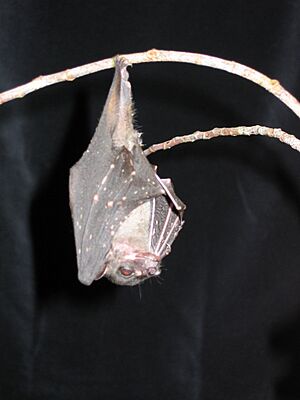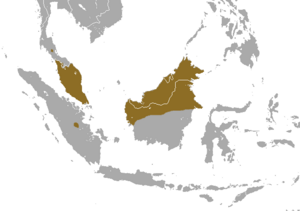Spotted-winged fruit bat facts for kids
Quick facts for kids Spotted-winged fruit bat |
|
|---|---|
 |
|
| Conservation status | |
| Scientific classification | |
 |
|
| Spotted-winged fruit bat range |
The spotted-winged fruit bat (Balionycteris maculata) is the smallest megabat in the world. It lives in forests in countries like Brunei, Indonesia, Malaysia, and Thailand. This tiny bat is special because of the cool spots on its wings!
What Does It Look Like?
Spotted-winged fruit bats are very small megabats. They are only about 5.2 to 6.2 centimetres (2.0 to 2.4 in) long from head to body. Their wings can spread up to 28 centimetres (11 in) wide. An adult bat weighs around 13 grams (0.46 oz), which is about the same as two quarters.
Their fur is thick and blackish-brown on most of their body. Their belly is a lighter grey-brown color. The wings are dark brown, but they have special pale cream spots. You can see these spots clearly on their wing joints. The spots also form different patterns across the rest of their wings.
These bats have large eyes and simple ears. They also have long nostrils that spread out on the sides of their snout. You can tell them apart from other small fruit bats by the spots on their wings. They also have a unique set of teeth.
Where Do They Live?
Spotted-winged fruit bats live in very old rain forests. They can be found up to 1,500 metres (4,900 ft) high in the mountains. They also live in mangrove forests near the coast.
You can find them all over Malaysia and Brunei. They also live in the northern and western parts of Borneo in Indonesia. Sometimes, they are seen in southern Thailand, a small part of Sumatra, and the Riau Archipelago.
How Do They Live?
Spotted-winged fruit bats look for food in the thick parts of the forest. They mostly eat small fruits like figs and persimmon. They also sometimes eat insects and spiders.
During the day, these bats rest alone or in small groups. A group might have one male bat, up to nine female bats, and their young. Female bats might visit different males, not just stay with one. Males often return to the same resting spots at night. This suggests they might control these spots to attract females.
These bats look for food by themselves, not in groups. They usually stay close to their resting spot, traveling less than 1 kilometre (0.62 mi) away. When they are looking for food, they make high-pitched "peep" noises. They also make more complex sounds when they are socializing with other bats.
Their resting places are always the same shape and size. These bats might even dig out parts of their roosts themselves! This is a very unusual behavior for this type of animal. They often rest in the roots of plants that grow on other plants, like ferns. They also use the nests of ants and termites as roosts.
Reproduction and Life Cycle
Female spotted-winged fruit bats usually have one baby at a time. They can give birth up to twice a year, usually between June and January.
When baby bats are born, they cannot see. They weigh about 3.5 grams (0.12 oz). They stay with their mother for about 135 days before they are born. Young bats drink their mother's milk for 40 to 80 days. They can fly when they weigh about 5 grams (0.18 oz). Female bats are ready to have their own babies when they are about ten months old.


